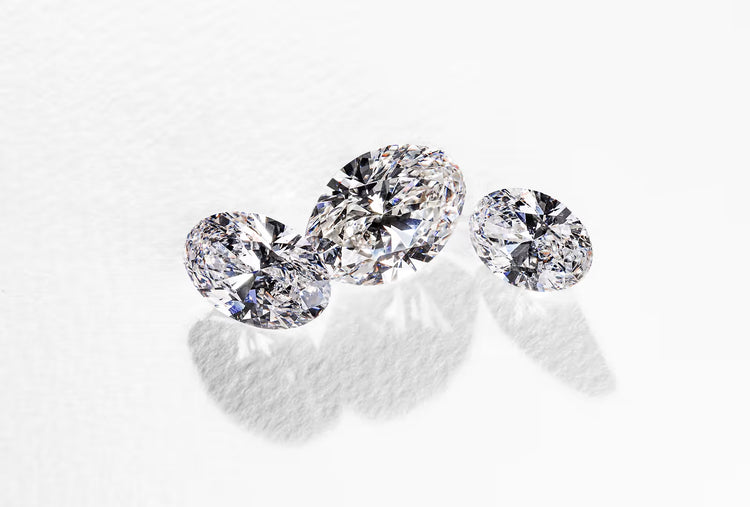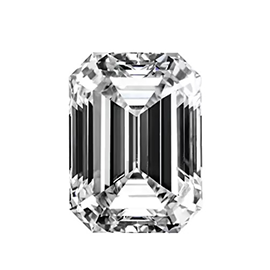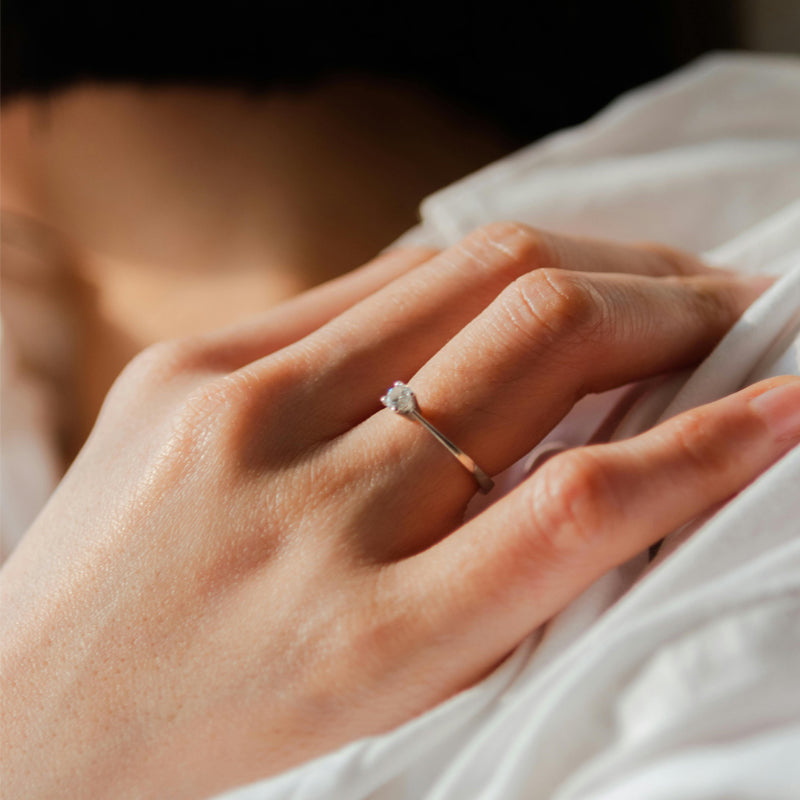What Are Lab Grown Diamonds?
Lab grown diamonds, also known as engineered diamonds, synthetic diamonds, and lab diamonds, are REAL diamonds. They are grown in a controlled laboratory environment using advanced technology to replicate the earth's natural process of crystallizing carbon into brilliant diamonds.
Each diamond grown possesses the same chemical and physical properties as natural diamonds, making them chemically, optically, and physically identical to earth-mined diamonds. Not only do they offer a sustainable and ethical alternative, they come at a more affordable price point without compromising quality.

Can you tell the difference between an earth-mined diamond and a lab created diamond?
While both earth-mined diamonds and lab-created diamonds have the same chemical composition, only trained gemologists using advanced gemological equipment can detect differences in their growth patterns and inclusions. Advanced technology, such as UV fluorescence imaging and specific laser inscription patterns, aids in distinguishing between the two types. However, to the naked eye, without specialized equipment, it is nearly impossible to know the difference.
Do lab grown diamonds test positive on a diamond tester?
Yes, lab-grown diamonds do test positive on a diamond tester. Diamond testers work based on the principle of thermal conductivity, and lab-grown diamonds have the same thermal properties as natural diamonds, resulting in a positive test. These advanced testers can distinguish between diamonds and other gemstones, ensuring the authenticity of the stone. Whether mined or lab-grown, both types of diamonds will show a positive result on a reliable diamond tester, reassuring consumers and jewelers alike about the genuineness of the diamond they are examining.
Are lab grown diamond fake?
No, lab-grown diamonds are not fake. They are real diamonds with the same chemical composition as natural diamonds. The only difference lies in their origin. Lab-grown diamonds are created in controlled environments using cutting-edge technology. It's like getting your ice from your freezer versus getting ice from a glacier. These diamonds possess the same brilliance, hardness, and beauty as their mined counterparts.
Do all lab grown diamond look alike?
No, not all lab-grown diamonds look alike. Lab-grown diamonds exhibit the same variations in color, clarity, and cut as their mined counterparts. We put the right conditions together in a lab, but nature takes it from there and grows us a diamond. Advanced technology allows us to create a wide range of lab-grown diamonds with diverse appearances, catering to individual preferences and styles. From classic white diamonds to fancy colors, each lab-grown gem possesses a distinct allure.
Are Grown Diamonds Real?
Yes! It's a fact that lab diamonds are real diamonds, identical in every way (but the price!) to earth-mined diamonds. Except that AurelliaGems lab-grown diamonds are better than 99% of all other diamonds, no matter their origin.
Not to be confused with cubic zirconia, moissanite, or a "look-a-like" diamond, grown diamonds are 100% pure crystallized carbon. Think of it as making ice in your modern-day freezer versus getting it from a glacier. Both are frozen H2O regardless of the origin.

The Best Lab-Grown Diamonds are only at AurelliaGems
We are the pioneers of the lab created diamond retail industry and have been selling lab diamonds directly to consumers since 2015. Our created diamonds are superior to earth-mined diamonds and other grown diamonds on the market today.

AurelliaGems LAB-GROWN
Graded the same: 1.02ct, SI2, H

COMPETITOR LAB-GROWN
Graded the same: 1.02ct, SI2, H
SUPERIOR TO OTHER LAB CREATED DIAMONDS
We are now seeing many lab-created diamonds hitting the market that don’t measure up. We grow our diamonds in the world’s most technologically advanced laboratories using innovative growth methods, a slower growth cycle, and renewable energy sources, making our diamonds the best for both the environment and quality. Cheap lab diamonds are simply not worth your time or money— they're more brittle, post-treated to mimic clarity, and manufactured in facilities with questionable human rights and environmental practices.

What are the best lab grown diamonds?
The best lab diamonds are high quality, sustainable, and backed by third-party verifications. There are many types of lab diamonds on the market that do not measure up in quality or ethics.High Quality: Type lla diamond, grown using CVD technology and untouched by any post-treatment, finished with an exceptional cut. Learn more about the best lab grown diamonds.Sustainability: Not all lab diamonds are sustainable. Make sure diamond is grown with renewable energy and or carbon-capturing resources and gives back to mining communities.Proof: Lab grown diamonds must come with third-party verifications on technology and grading for your protection.
Are lab grown diamonds less sparkly?
Lab-grown diamonds, if grown slowly and are not post-treated, are as sparkly as their mined counterparts. Although all diamonds, whether lab or minded, share the same physical and chemical properties, some post-treatments can damage the internal structure of the diamond, causing them to be less sparkly. That is why it's paramount only to purchase high-quality lab-grown diamonds.
What are the quality grades of lab diamonds?
Lab-grown diamonds are graded based on the same 4 Cs and exhibit the same variations in color, clarity, and cut like their mined counterparts. However, Type lla diamonds from AurelliaGems contain such a pure form of carbon they will appear brighter than the regular Type Ia. The same color grades in a Type la mined or lab diamond will look duller than a Type lla diamond in the same color grades.
What is a high-quality lab-grown diamond?
Beyond sustainability, the highest quality lab diamond is a Type lla diamond grown using CVD technology and untouched by any post-treatment. This pioneering approach must be paired with an exacting cut to capture extraordinary light dispersion and sparkle—such diamonds merit evaluation against rigorous benchmarks like AGS or GCal 8x cut grading. At AurelliaGems, this distinction is inherent, making our diamonds the highest quality – the top 1% of all diamonds.
How to choose the right lab grown diamond?
Quality: Make sure your lab diamond is high quality with an exceptional cut.Certification: Your lab-grown diamond must come with third-party verifications on technology and grading.Sustainability: Grown with renewable energy resources and give back to mining communities.
How Much Do Lab Grown Diamonds Cost?
On average, AurelliaGems created diamonds are priced up to 50% less than an earth-mined diamond of equivalent quality. However, the price of a lab-grown diamond depends on various factors such as the 4 c’s - carat weight, cut, color, and clarity, just like mined diamonds. This affordability opens up a world of possibilities, allowing you to choose a larger or higher quality lab-grown diamond for your budget. So, if you're looking for exceptional value without compromising on beauty, lab-grown diamonds are an enticing and cost-effective choice.

What factors influence the price of lab-grown diamonds?
The difference in price is because our supply chain is so much shorter. Earth-mined diamonds can travel to five countries and touch 20 hands before it reaches the end consumer. AurelliaGems lab-created diamonds go from our labs to our casting house to you. Not only is it more efficient, but it’s also better for your wallet and the environment.

How Much Do Lab Grown Diamonds Cost?
On average, AurelliaGems created diamonds are priced up to 50% less than an earth-mined diamond of equivalent quality. However, the price of a lab-grown diamond depends on various factors such as the 4 c’s - carat weight, cut, color, and clarity, just like mined diamonds. This affordability opens up a world of possibilities, allowing you to choose a larger or higher quality lab-grown diamond for your budget. So, if you're looking for exceptional value without compromising on beauty, lab-grown diamonds are an enticing and cost-effective choice.
What factors influence the price of lab-grown diamonds?
The difference in price is because our supply chain is so much shorter. Earth-mined diamonds can travel to five countries and touch 20 hands before it reaches the end consumer. AurelliaGems lab-created diamonds go from our labs to our casting house to you. Not only is it more efficient, but it’s also better for your wallet and the environment.
Can I get a larger lab-grown diamond for the same price as a smaller natural diamond?
Yes, it's possible to get a much larger lab-grown diamond for the same price as a smaller natural diamond. This cost difference allows you to choose a larger lab-grown diamond with similar specifications for the price of a smaller natural diamond. However, consider that lab-grown diamonds offer the same brilliance, sparkle, and durability as natural diamonds, making them an attractive and budget-friendly alternative for those seeking a bigger stone without compromising on quality.
Do lab-grown diamonds retain their value over time?
Yes! But you have to consider the quality of your lab diamond just like you would an earth-mined diamond. Post treatments in lab-grown diamonds or natural diamonds will lower the value. Not having a reputable USA grading certificate will also lower the value of your diamond.
How are Lab Grown Diamonds Made?
Grown diamonds are made one of two ways— either through High-Pressure High-Temperature (HPHT), or through Chemical Vapor Deposition (CVD). The majority of MiaDonna’s diamonds are grown using CVD which has been the most successful method in producing higher quality diamonds.
What is Chemical Vapor Deposition (CVD)
Scientists start the process of growing a MiaDonna diamond by cutting a small piece of carbon, known as a seed. It is placed in a low-pressure microwave chemical vapor deposition (CVD) chamber. Hydrogen and methane gases combine with electrical energy, which ignites a plasma ball. From there, a cloud forms in the chamber, and carbon molecules rain on the seed. Within six to 12 weeks, a sizable rough diamond is formed. It is then cut, polished, and graded by the same world-renowned labs that certify earth-mined diamonds.

What is Chemical Vapor Deposition (CVD)
Scientists start the process of growing a MiaDonna diamond by cutting a small piece of carbon, known as a seed. It is placed in a low-pressure microwave chemical vapor deposition (CVD) chamber. Hydrogen and methane gases combine with electrical energy, which ignites a plasma ball. From there, a cloud forms in the chamber, and carbon molecules rain on the seed. Within six to 12 weeks, a sizable rough diamond is formed. It is then cut, polished, and graded by the same world-renowned labs that certify earth-mined diamonds.

How are Lab Grown Diamonds Made?
Grown diamonds are made one of two ways— either through High-Pressure High-Temperature (HPHT), or through Chemical Vapor Deposition (CVD). The majority of MiaDonna’s diamonds are grown using CVD which has been the most successful method in producing higher quality diamonds.
What is Chemical Vapor Deposition (CVD)
Scientists start the process of growing a MiaDonna diamond by cutting a small piece of carbon, known as a seed. It is placed in a low-pressure microwave chemical vapor deposition (CVD) chamber. Hydrogen and methane gases combine with electrical energy, which ignites a plasma ball. From there, a cloud forms in the chamber, and carbon molecules rain on the seed. Within six to 12 weeks, a sizable rough diamond is formed. It is then cut, polished, and graded by the same world-renowned labs that certify earth-mined diamonds. Learn more about Chemical Vapor Deposition Diamonds.
What is High Pressure High Temperature (HPHT)
HPHT recreates the natural growing environment found within the earth and is typically used to grow smaller gem diamonds. There are a few different types of HPHT technologies used. But the process best suited for producing gem-quality Lab Grown Diamonds to be set in finished jewelry is created using a BARS press.The BARS press was invented by Russian scientists and uses a combination of inner and outer anvils to apply hydraulic pressure to the growth cell within the unit. The growth cell itself contains all the elements necessary to grow a diamond, including a tiny diamond seed, highly refined graphite, and a catalyst consisting of a mixture of metals and powders.Consistent temperatures reaching 1,300 degrees Celsius and over 50,000 atmospheres of pressure are applied to the growth cell. Over a few days, the elements within the growth cell melt and then reform during cooling to create finished, rough, Lab Grown Diamonds ready to be extracted for cutting and polishing. Learn more about High Pressure High Temperature Diamonds.
What are Carbon-captured diamonds
Carbon-captured diamonds, also known as carbon-neutral diamonds, refer to lab-grown diamonds created using a process that captures and recycles carbon emissions from our atmosphere, aka pollution. This innovative approach aims to utilize carbon emissions that would otherwise contribute to greenhouse gasses, making them not only sustainable but works to reduce your carbon footprint. These lab-grown diamonds provide the most eco-friendly and sustainable option for consumers concerned about the environmental impact of their jewelry choices.
How are colored diamonds made?
Colored lab diamonds are crafted through controlled processes mimicking natural diamond formation. By introducing specific trace elements during growth, lab-grown diamonds acquire various hues. Boron results in blue shades, while nitrogen leads to yellows and oranges. Radiation exposure can create green and pink tones. Learn more about colored lab created diamonds.
What is the difference between Lab-grown diamonds and diamond simulants?
Lab-grown diamonds are genuine diamonds created in labs with the same physical, chemical, and optical properties as natural diamonds. They're made from carbon, like natural diamonds. In contrast, diamond simulants like cubic zirconia or moissanite may look similar but lack the same chemical composition and properties. Lab-grown diamonds possess authenticity, durability, and brilliance, while simulants mimic the appearance without sharing the diamond's intrinsic qualities.





